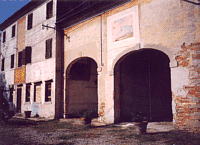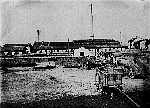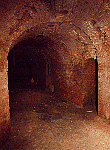 |
 |
 |
 |
The discontinuous fire oven. This kiln was fitted from the start with a "discontinuous fire oven" for the baking of bricks, fed by wood and straw. The bricks were mixed by hand and dried in the sun, laid out in long stacks protected by mats and were then placed in the cold oven.
The oven was then heated, first with a slow flame in order to complete the drying out and then at full heat in order to cook them through. The production was necessarily discontinuous and the workmen needed were found even amongst the agricultural workers who alternated work in the fields with work in the kilns. The clay for the bricks was excavated locally on the grounds of the family property.
The Hoffmann oven and the continuous cycle production. Between 1888 and 1890 a new Hoffmann style oven was constructed and the production was reorganised. The objectives that Gregorio Gregorj aimed for were the following four:
 The new oven was built on the foundation of the old one, after the
fire of 1887, with a length of about 30 metres less than the 80 - 100 metres typical of
Hoffmann ovens at that time. The construction was an elliptical form, entirely in brick
with air spaces filled with sand, with 16 niches around it, into which approximately
100,000 bricks at a time could be inserted.
The new oven was built on the foundation of the old one, after the
fire of 1887, with a length of about 30 metres less than the 80 - 100 metres typical of
Hoffmann ovens at that time. The construction was an elliptical form, entirely in brick
with air spaces filled with sand, with 16 niches around it, into which approximately
100,000 bricks at a time could be inserted.
The baking occurred in these niches, which communicated directly with the fire place where the fuel was burned, mostly carbon powder. The single compartments could be loaded and unloaded one at a time, isolating them from the fire and this allowed for a continuous production.
The continuous fire oven could be used to its maximum on the condition that the entire productive cycle could be completely balanced and had an equal production capacity in each of its 5 phases: excavation and transport, mincing and mixing, forming the bricks, drying, baking.
 The mechanical work. In order to obtain
a continuous production rhythm different machines were introduced and part of the manual
work was substituted by mechanical work. A cylindrical crusher, a mixer, a cylindrical
rolling mill, a brick maker, and a strainer were adopted. In addition, the drying out
phase was done in part on the floor above the Hoffmann oven, where there was the correct
amount of heat available.
The mechanical work. In order to obtain
a continuous production rhythm different machines were introduced and part of the manual
work was substituted by mechanical work. A cylindrical crusher, a mixer, a cylindrical
rolling mill, a brick maker, and a strainer were adopted. In addition, the drying out
phase was done in part on the floor above the Hoffmann oven, where there was the correct
amount of heat available.
The new machinery was driven by petroleum fuel motors since 1898 and up until the twenty years of Fascism, when the motors were bought by the Podestà of Treviso to be sent to the colonies in Africa, and subsequently were substituted by electrical ones. The renovation required the skill of specially trained workmen and brought the number of personnel up to 100 labourers in 1896. The production of the bricks reached 3-4 million pieces per year and four external deposits were functional: two in Venice, one at Oderzo and one at Sacile.

The ceramics. For the production of ceramics there were four tubular ovens for glazing:
Other equipment for the production of ceramics included the lathe for vases, the hand stamping device for tiles, and plaster moulds for the small decorative pieces. The moulds were realised in the workshop of the kiln. Among the blacksmiths who offered their specialised services to the works was Giovanni Torresan, present in the company up until the last years of its activity, and who dedicated himself also to the production of wrought iron, well known and appreciated in the city of Treviso.
Experiments and patents
. Diverse experiments were conducted which led to the introduction of two new products: special bricks with smooth edges and faces and bricks glazed at high heat, these last produced using a method patented in 1895. Since 1895 the production of tiles and special bricks made from opaque porcelain with glazes in high heat majolica was experimented with and for which a testament of industrial monopoly was obtained in 1903.With these products panelling and artistic decorations were done in majolica graffito and relief. In order to improve the quality of the products the "furnace worker" Gregorio conducted various research projects which allowed him to obtain bricks with a fibrous texture and resistant to atmospheric agents. This research and other facts and technical innovations regarding the industries of the ceramics field were dealt with in the "Bulletin of the Ceramics Industry" , which Gregorio Gregorj was both director and founder.
The materials. With the introduction of new products there was no need to resort only to the clay extracted in the St. Antonino area, but also other material could be used. The local clay was alluvial, particularly adapted to the production of bricks resistant to extreme temperature changes. Rather clay of a "static" origin was imported from France and Germany, static intending clay produced by the decomposition of rocks, and was used for interior use tiles. For the high heat glazed bricks, refractory earth was imported from Holland and England. For the exterior panelling mostly red clay from Montello was used.
The material for giving particular colorations to the glazes, such as iron oxide, uranium, lead and lapis lazuli from Florence was ground and submitted to numerous tests before being used, according to the defined methods. Among the technical documentation of the archives of the kilns, there are the recipes tested in the laboratory and the results of the experiments.
|
|
© Luisa Gregorj 2002 |